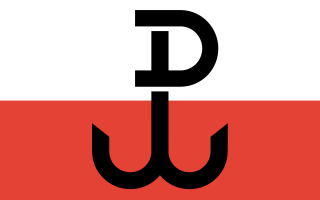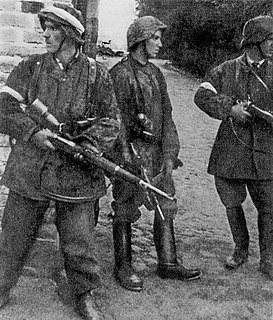
Żydowski Związek Wojskowy was an underground resistance organization operating during World War II in the area of the Warsaw Ghetto, which fought during the Warsaw Ghetto Uprising and 1944 Warsaw Uprising. It was formed, primarily of former officers of the Polish Army, in late 1939, soon after the start of the German occupation of Poland.

The Polish Underground State was a single political and military entity formed by the union of resistance organizations in occupied Poland that were loyal to the Government of the Republic of Poland in exile in London. The first elements of the Underground State were established in the final days of the German and Soviet invasion of Poland, in late September 1939. The Underground State was perceived by supporters as a legal continuation of the pre-war Republic of Poland that waged an armed struggle against the country's occupying powers: Nazi Germany and the Soviet Union. The Underground State encompassed not only military resistance, one of the largest in the world, but also civilian structures, such as education, culture and social services.

The Kotwica was a World War II emblem of the Polish Underground State and Armia Krajowa. It was created in 1942 by members of the AK Wawer Minor sabotage unit, as an easily usable emblem for the Polish struggle to regain independence. The initial meaning of the initials PW was Pomścimy Wawer. This was a reference to the Wawer massacre, which was considered to be one of the first large scale massacres of Polish civilians by German troops in occupied Poland.

Directorate of Civil Resistance was one of the branches of the Polish Government Delegate’s Office during World War II. Its main tasks were to maintain the morale of the Polish society, encourage passive resistance, report German atrocities and cruelties to the Polish Government in Exile, and to organize sabotage. In addition, it was responsible for the law and justice in occupied Poland.

Directorate of Underground Resistance was an agency of the Polish Underground State created during World War II.

The Government Delegation for Poland was an agency of the Polish Government in Exile during World War II. It was the highest authority of the Polish Secret State in occupied Poland and was headed by the Government Delegate for Poland, a de facto deputy Polish Prime Minister.

Armia Ludowa was a communist partisan force set up by the communist Polish Workers' Party (PPR) during World War II. It was created on the order of the Polish State National Council on 1 January 1944. Its aims were to fight against Nazi Germany in occupied Poland, support the Soviet Red Army against the German forces and aid in the creation of a pro-Soviet communist government in Poland.

Bataliony Chłopskie was a Polish World War II resistance movement, guerrilla and partisan organisation. The organisation was created in mid-1940 by the agrarian political party People's Party and by 1944 was partially integrated with the Armia Krajowa. At its height, in summer 1944 the organisation had 160,000 members.

Wachlarz was a Polish World War II resistance organization formed by the Armia Krajowa for sabotage duties behind the German Eastern Front, outside of the Polish borders. Its commanders were Lieutenant Colonel Jan Włodarkiewicz and Lieutenant Colonel Adam Remigiusz Grocholski.

Lieutenant Colonel Jan Włodarkiewicz was a Polish soldier, an officer of the Polish Army and a freedom fighter during World War II. He is notable as the first commander of the Wachlarz, the first secret service formed by an underground resistance organization in occupied Europe.
Józef Chyliński was a Polish soldier and resistance fighter, recipient of the Silver Star of the Virtuti Militari, Cross of Valour and Gold Cross of Merit with Swords.

The Polish resistance movement in World War II, with the Polish Home Army at its forefront, was the largest underground resistance movement in all of occupied Europe, covering both German and Soviet zones of occupation. The Polish resistance is most notable for disrupting German supply lines to the Eastern Front, providing intelligence reports to the British intelligence agencies, and for saving more Jewish lives in the Holocaust than any other Western Allied organization or government. It was a part of the Polish Underground State.
NIE was a Polish anticommunist resistance organisation formed in 1943. Its main goal was the struggle against the Soviet Union after 1944. NIE was one of the best hidden structures of Armia Krajowa, active until 7 May 1945. Its commanders were Generals Leopold Okulicki and Emil August Fieldorf. One of the first members of the organisation was Witold Pilecki.

Tadeusz Żenczykowski, pseudonym Kania, Kowalik and Zawadzki was a Polish lawyer, political activist and soldier in the Armia Krajowa during World War II, taking part in the Warsaw Uprising of 1944. Immediately after the war, he was a member of the anti-communist conspiracy in Poland. In 1945, he emigrated and became a journalist and deputy chief of the Polish Section of Radio Free Europe, historian and publicist.

Armia Krajowa Cross is a Polish military decoration that was introduced by General Tadeusz Bór-Komorowski on 1 August 1966 to commemorate the efforts of the soldiers of the Polish Secret State between 1939 and 1945. The decoration was awarded to soldiers of the Home Army and of its predecessor organizations.
Helena Pasierbska-Wojtowicz was a Polish writer.

The Battle of Osuchy was one of the largest battles between the Polish resistance and Nazi Germany in occupied Poland during World War II, a part of the Zamość Uprising. It took place near the village of Osuchy in the Solska Forest on 25–26 June 1944 during the German anti-partisan Operation Sturmwind II. The battle ended with the defeat of the local resistance forces that suffered heavy casualties.
Narodowe Zjednoczenie Wojskowe was a Polish anti-Communist organization, founded in November 1944, after collapse of the Warsaw Uprising. It was among the largest and strongest resistance organizations established in the Soviet-controlled Poland in mid- and late 1940s. The NZW consisted mostly of members of destroyed Narodowe Sily Zbrojne and disbanded Armia Krajowa.

The Bureau of Information and Propaganda of the Headquarters of Związek Walki Zbrojnej, later of Armia Krajowa a conspiracy department created in spring 1940 during the German occupation of Poland, inside the Związek Walki Zbrojnej, then of the Supreme Command of Armia Krajowa.

Operation N was a complex of sabotage, subversion and black-propaganda activities carried out by the Polish resistance against Nazi German occupation forces during World War II, from April 1941 to April 1944. These activities were organized by Office N, which in October 1941 was transformed into an Autonomous Sub-Department N of the Bureau of Information and Propaganda of the Armed Resistance, later of the Home Army. It was headed by Tadeusz Żenczykowski.












